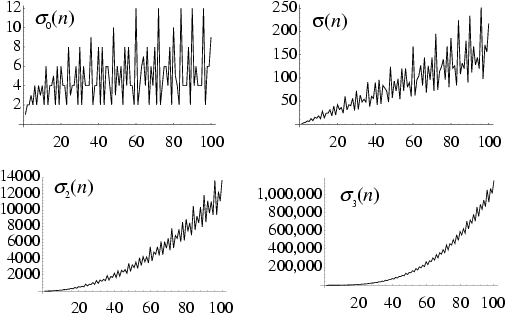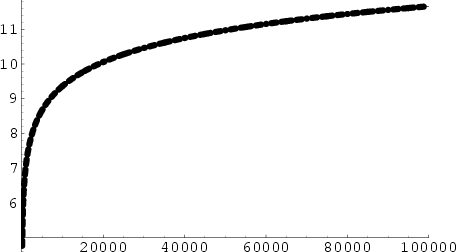| 释义 |
Divisor Function is defined as the sum of the is defined as the sum of the  th Powers of the Divisors of th Powers of the Divisors of  . Thefunction . Thefunction  gives the total number of Divisors of gives the total number of Divisors of  and is often denoted and is often denoted  , ,  , , , or , or  (Hardy and Wright 1979, pp. 354-355). The first few values of (Hardy and Wright 1979, pp. 354-355). The first few values of  are 1, 2, 2, 3, 2, 4,2, 4, 3, 4, 2, 6, ... (Sloane's A000005). The function are 1, 2, 2, 3, 2, 4,2, 4, 3, 4, 2, 6, ... (Sloane's A000005). The function  is equal to the sum of Divisors of is equal to the sum of Divisors of and is often denoted and is often denoted  . The first few values of . The first few values of  are 1, 3, 4, 7, 6, 12, 8, 15, 13, 18, ...(Sloane's A000203). The first few values of are 1, 3, 4, 7, 6, 12, 8, 15, 13, 18, ...(Sloane's A000203). The first few values of  are 1, 5, 10, 21, 26, 50, 50, 85, 91, 130, ... (Sloane's A001157). Thefirst few values of are 1, 5, 10, 21, 26, 50, 50, 85, 91, 130, ... (Sloane's A001157). Thefirst few values of  are 1, 9, 28, 73, 126, 252, 344, 585, 757, 1134, ... (Sloane's A001158). are 1, 9, 28, 73, 126, 252, 344, 585, 757, 1134, ... (Sloane's A001158).
The sum of the Divisors of  excluding excluding  itself (i.e., the Proper Divisors of itself (i.e., the Proper Divisors of  ) is called the Restricted Divisor Function and is denoted ) is called the Restricted Divisor Function and is denoted  . The first few values are 0, 1,1, 3, 1, 6, 1, 7, 4, 8, 1, 16, ... (Sloane's A001065). . The first few values are 0, 1,1, 3, 1, 6, 1, 7, 4, 8, 1, 16, ... (Sloane's A001065).
As an illustrative example, consider the number 140, which has Divisors  , 2, 4, 5, 7, 10, 14, 20,28, 35, 70, and 140 (for a total of , 2, 4, 5, 7, 10, 14, 20,28, 35, 70, and 140 (for a total of  of them). Therefore, of them). Therefore,
The  function has the series expansion function has the series expansion  | |  | (5) |
(Hardy 1959). It also satisfies the Inequality
 | (6) |
 is the Euler-Mascheroni Constant (Robin 1984, Erdös 1989). is the Euler-Mascheroni Constant (Robin 1984, Erdös 1989).
Let a number  have Prime factorization have Prime factorization
 | (7) |
 | (8) |
 | (9) |
 is the Euler-Mascheroni Constant. is the Euler-Mascheroni Constant.
In general,
 | (10) |
 showed that the average number of Divisors of all numbers from 1 to showed that the average number of Divisors of all numbers from 1 to  isasymptotic to isasymptotic to
 | (11) |
A curious identity derived using Modular Form theory is given by
 | (12) |
The asymptotic Summatory Function of  is given by is given by
 | (13) |
 | (14) |
 with with  are are
 | (15) |
 , ,
 | (16) |
 is a Square Number or twice a Square Number. The divisorfunction satisfies the Congruence is a Square Number or twice a Square Number. The divisorfunction satisfies the Congruence
 | (17) |
 is Prime whenever is Prime whenever  is (Honsberger 1991). Factorizations of is (Honsberger 1991). Factorizations of  for Prime for Prime are given by Sorli.See also Dirichlet Divisor Problem, Divisor, Factor, Greatest Prime Factor, Gronwall'sTheorem, Least Prime Factor, Multiply Perfect Number, Ore's Conjecture, Perfect Number,r(n), Restricted Divisor Function, Silverman Constant, Tau Function, Totient Function,Totient Valence Function, Twin Peaks are given by Sorli.See also Dirichlet Divisor Problem, Divisor, Factor, Greatest Prime Factor, Gronwall'sTheorem, Least Prime Factor, Multiply Perfect Number, Ore's Conjecture, Perfect Number,r(n), Restricted Divisor Function, Silverman Constant, Tau Function, Totient Function,Totient Valence Function, Twin Peaks
References
Abramowitz, M. and Stegun, C. A. (Eds.). ``Divisor Functions.'' §24.3.3 in Handbook of Mathematical Functions with Formulas, Graphs, and Mathematical Tables, 9th printing. New York: Dover, p. 827, 1972.Berndt, B. C. Ramanujan's Notebooks: Part I. New York: Springer-Verlag, p. 94, 1985. Conway, J. H. and Guy, R. K. The Book of Numbers. New York: Springer-Verlag, pp. 260-261, 1996. Dickson, L. E. History of the Theory of Numbers, Vol. 1: Divisibility and Primality. New York: Chelsea, pp. 279-325, 1952. Dirichlet, G. L. ``Sur l'usage des séries infinies dans la théorie des nombres.'' J. reine angew. Math. 18, 259-274, 1838. Erdös, P. ``Ramanujan and I.'' In Proceedings of the International Ramanujan Centenary Conference held at Anna University, Madras, Dec. 21, 1987. (Ed. K. Alladi). New York: Springer-Verlag, pp. 1-20, 1989. Guy, R. K. ``Solutions of  ,'' ``Analogs with ,'' ``Analogs with  , ,  ,'' ``Solutions of ,'' ``Solutions of  ,'' and ``Solutions of ,'' and ``Solutions of  .'' §B11, B12, B13 and B15 in Unsolved Problems in Number Theory, 2nd ed. New York: Springer-Verlag, pp. 67-70, 1994. .'' §B11, B12, B13 and B15 in Unsolved Problems in Number Theory, 2nd ed. New York: Springer-Verlag, pp. 67-70, 1994. Hardy, G. H. Ramanujan: Twelve Lectures on Subjects Suggested by His Life and Work, 3rd ed. New York: Chelsea, p. 141, 1959. Hardy, G. H. and Weight, E. M. An Introduction to the Theory of Numbers, 5th ed. Oxford, England: Oxford University Press, pp. 354-355, 1979. Honsberger, R. More Mathematical Morsels. Washington, DC: Math. Assoc. Amer., pp. 250-251, 1991. Robin, G. ``Grandes valeurs de la fonction somme des diviseurs et hypothese de Riemann.'' J. Math. Pures Appl. 63, 187-213, 1984. Sloane, N. J. A. SequencesA000005/M0246,A000203/M2329A001065/M2226,A001157/M3799, andA001158/M4605,in ``An On-Line Version of the Encyclopedia of Integer Sequences.''http://www.research.att.com/~njas/sequences/eisonline.html and Sloane, N. J. A. and Plouffe, S.The Encyclopedia of Integer Sequences. San Diego: Academic Press, 1995. Subbarao, M. V. ``On Two Congruences for Primality.'' Pacific J. Math. 52, 261-268, 1974.
|

![]() is defined as the sum of the
is defined as the sum of the ![]() th Powers of the Divisors of
th Powers of the Divisors of ![]() . Thefunction
. Thefunction ![]() gives the total number of Divisors of
gives the total number of Divisors of ![]() and is often denoted
and is often denoted ![]() ,
, ![]() ,
,![]() , or
, or ![]() (Hardy and Wright 1979, pp. 354-355). The first few values of
(Hardy and Wright 1979, pp. 354-355). The first few values of ![]() are 1, 2, 2, 3, 2, 4,2, 4, 3, 4, 2, 6, ... (Sloane's A000005). The function
are 1, 2, 2, 3, 2, 4,2, 4, 3, 4, 2, 6, ... (Sloane's A000005). The function ![]() is equal to the sum of Divisors of
is equal to the sum of Divisors of![]() and is often denoted
and is often denoted ![]() . The first few values of
. The first few values of ![]() are 1, 3, 4, 7, 6, 12, 8, 15, 13, 18, ...(Sloane's A000203). The first few values of
are 1, 3, 4, 7, 6, 12, 8, 15, 13, 18, ...(Sloane's A000203). The first few values of ![]() are 1, 5, 10, 21, 26, 50, 50, 85, 91, 130, ... (Sloane's A001157). Thefirst few values of
are 1, 5, 10, 21, 26, 50, 50, 85, 91, 130, ... (Sloane's A001157). Thefirst few values of ![]() are 1, 9, 28, 73, 126, 252, 344, 585, 757, 1134, ... (Sloane's A001158).
are 1, 9, 28, 73, 126, 252, 344, 585, 757, 1134, ... (Sloane's A001158).![]() excluding
excluding ![]() itself (i.e., the Proper Divisors of
itself (i.e., the Proper Divisors of ![]() ) is called the Restricted Divisor Function and is denoted
) is called the Restricted Divisor Function and is denoted ![]() . The first few values are 0, 1,1, 3, 1, 6, 1, 7, 4, 8, 1, 16, ... (Sloane's A001065).
. The first few values are 0, 1,1, 3, 1, 6, 1, 7, 4, 8, 1, 16, ... (Sloane's A001065).![]() , 2, 4, 5, 7, 10, 14, 20,28, 35, 70, and 140 (for a total of
, 2, 4, 5, 7, 10, 14, 20,28, 35, 70, and 140 (for a total of ![]() of them). Therefore,
of them). Therefore,


![]() function has the series expansion
function has the series expansion

![]() have Prime factorization
have Prime factorization



![]() is given by
is given by



![]() ,'' ``Analogs with
,'' ``Analogs with ![]() ,
, ![]() ,'' ``Solutions of
,'' ``Solutions of ![]() ,'' and ``Solutions of
,'' and ``Solutions of ![]() .'' §B11, B12, B13 and B15 in Unsolved Problems in Number Theory, 2nd ed. New York: Springer-Verlag, pp. 67-70, 1994.
.'' §B11, B12, B13 and B15 in Unsolved Problems in Number Theory, 2nd ed. New York: Springer-Verlag, pp. 67-70, 1994.